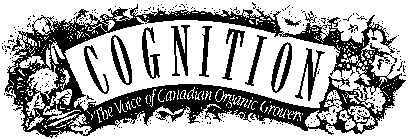

Cognition Index | Virtual Library
| Magazine Rack
Search
| Join the Ecological Solutions Roundtable
MARY’S GARDEN
by Mary Perlmutter
Most of us are beginning to get itchy fingers at this time of year. I have been perusing the seed catalogues even though most of the cultivars that will be planted in my garden are grown from seed that I saved from last fall.;
Every fall, I bring in sifted compost to mix 1:1 with vermiculite or perlite. This is the potting mix I use for starting seeds and keeping my house plants happy.
There is an interesting new material for starting seedlings. Last spring at the Master Gardener’s Convention at Guelph University, all present were given a Gro Brix made from a high lignin fibre with a pH range of 5.4 to 6.8 (slightly acidic). The brick is able to absorb 8 - 9 litres of water. This totally organic medium has a lignin content of 70 per cent. When placed in a 10-litre container with 4.5 litre of hot water, the brick expands and can be manually mixed with one part compost and one part coarse sand. This mixture is then used to plant the seeds for transplanting after all danger of frost is over. I am going to use my brick this spring and report to you next summer as to the effectiveness of this growing medium.
An avid recycler, I have never bought any plastic seed planters or the trays to hold them. Instead, I remove these useful 4-, 6-, or 8-celled packs from the solid waste stream in front of homes where gardeners are hired to plant the flower beds. Styrofoam containers used for packaging, gathered from the same source, are also useful for seedlings. We are presently clipping leaf lettuce from such a styrofoam planter in our southern living room window. This ‘cut and come again’ bed was planted in October. The planter is light enough to be moved during the day to follow the sun.
Park Seed Co. has a Canadian Catalogue Office at P.O. Box 1051, Fort Erie, ON, L2A 5N8. The catalogue has a centre fold called "Index, Germination, and Culture Guide." I have removed this index, put it into a clear plastic envelope, and hung it on a nail in the basement potting room. I refer to this guide many times in the spring and even in summer, so much information is packed on these two pages.
Thompson & Morgan, an international seed firm, has a wide variety of ornamentals and flowers listed. Their vegetable section is not as large as Wm. Dam, Stokes, or Dominion Seed House but they do carry quite a few of my favorite vegetable cultivars such as Royalty purple podded snap bean. They also print little tips for organic growers on almost every other page, e.g., "To encourage pollination by insects try growing sweet peas along side your runner beans." They have a special flower package to attract beneficial and pollinating insects. Flower Petal Salad is a mixture for those who wish to add color and variety to the daily green salad.
In November, I had a request from the Durham Chapter of COG to talk about tree planting. This was a new subject but as I began to think about it, I realized that we have planted quite a number of trees over the last 23 years: a cedar hedge, a lilac hedge, and a briar rose hedge, twelve fruit trees, four nut trees and four espalier pear trees. I am presently growing a pine tree seed which was given at Toronto’s Earth Day Celebration last spring. The pine, growing in my greenhouse, has reached the height of 2.5 cm. (1")!
At the International Master Gardeners Conference two years ago, I picked up a wonderful book, The Simple Act of Planting a Tree: Healing Your Neighborhood, Your City, Your World, written by Tree People with Andy and Katy Lipkis.
Copyright © 1994.
Mary PerlmutterReprinted with permission. All rights reserved.
Info Request | Services | Become EAP Member | Site Map
Give us your comments about the EAP site
Ecological Agriculture Projects, McGill University (Macdonald
Campus)
Ste-Anne-de-Bellevue, QC, H9X 3V9 Canada
Telephone:
(514)-398-7771
Fax:
(514)-398-7621
Email: info@eap.mcgill.ca
To report problems or otherwise comment on the structure of this site, send mail to the Webmaster